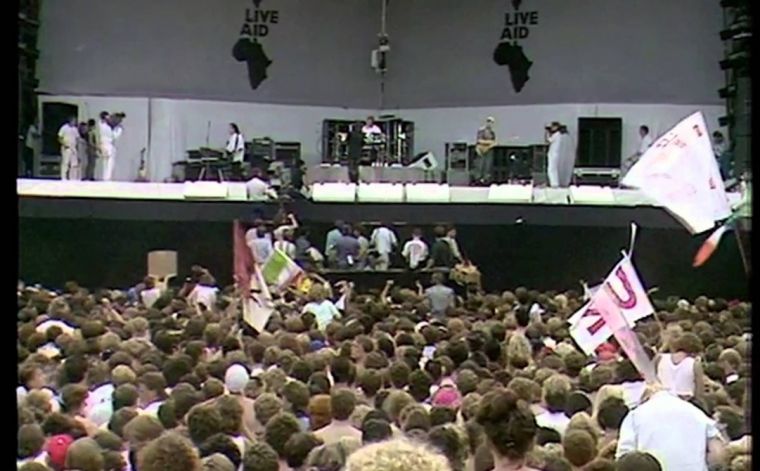Live Aid: the generation-defining event that helped save a people – but left a tainted legacy

It's one of the most iconic cultural moments of the 1980s. On both sides of the pond, tens of millions of people stopped what they were doing, turned on the their televisions and joined the tens of thousands who were actually there.
Live Aid only became possible because of the technological advances that meant satellite broadcasting was available. It was truly an event of its time, bringing together the biggest musical stars of the day to raise funds for starving people in Ethiopia and beyond.
Twenty-two years to the day since this iconic event, what is its legacy and what can we learn from its good and bad elements?
The harrowing reports from Ethiopia brought home the devastation of the famine there. The horrific abuses of the autocratic Mengistu government combined with lack of water were deadly. Hundreds of thousands were dying and the media began to pick the story up.
The most iconic reports came from the BBC's Michael Buerk. Standing amid the wreckage of a people and a country, Buerk intoned some of the most iconic words in TV news history.
'Dawn, and as the sun breaks through the piercing chill of night on the plains outside Korem,' he said, 'it lights up a biblical famine, now, in the 20th century. This place, say workers here, is the closest thing to hell on earth.'
Watching back in the UK were Bob Geldof and Midge Ure, both pop stars whose chart-topping days may have been behind them. Over the coming months, they recorded Do They Know Its Christmas? with a plethora of superstars, before planning Live Aid itself.
What started as a plan for a benefit concert in the UK soon became a generation-defining event. Main concerts were in London, at the iconic Wembley Stadium, and Philadelphia, at the John F Kennedy Stadium. The world's biggest stars appeared, from Madonna to David Bowie, Paul McCartney to Elton John. Other events were held around the world with a further list of superstars chipping in.
The concerts were, on one level, a resounding success. As well as drawing further attention to the plight of starving Ethiopians, they raised around £150m in donations – a colossal amount in 1985.
The events also proved that celebrities could come together for a greater cause and do something to benefit those most in need.
But ever since, there have been nagging doubts about Live Aid and its consequences.
There were the obvious criticisms, such as Bob Dylan's careless suggestion that some of the money be used to pay mortgages of struggling farmers in America. Some of the artists had broken the international boycott of South Africa to play to segregated audiences under apartheid – hardly the mark of enlightened philanthropists.
Yet there are three main ways in which the legacy of Live Aid is more tainted.
First, the portrayal of Africans as poverty-stricken and helpless. Though there is no doubt that there was acute need in Ethiopia at the time, the coverage probably played into a stereotype that already existed in the West of Africans being inferior and unable to manage their own affairs.
The coverage was not specific enough about the role of the autocratic Ethiopian regime in causing the famine, making the people affected seem like helpless victims of circumstance, rather than a people needing the dignity and agency we all are owed by right.
Second, the concert promoted the idea that charity was the solution to the world's problems. This was probably inevitable, given the short-term need to raise as much money as possible.
Yet for a generation it seemed that the primary mode of solving the problems in Africa (or elsewhere in the global south) was the beneficent action of the West. In this way, celebrities encouraging private charity become the solution.
Actually, of course, the solution to the problem is a more complex mix of trade, long-term aid, debt relief, tax reform, and above all the empowerment of local leaders to act on behalf of their people.
Third, Live Aid maintained a distance between the people who 'helped' and the people who were being helped. Viewing through our TV screens, we maintained a distance from those affected by the disaster and though many sent money, there was no actual relationship promoted.
Afterwards, we in the rich West knew as little of Ethiopian culture as we did before. We didn't experience the rich heritage of that country, its people, its ancient faith and churches, the beauty of its countryside or anything else.
Of course, this is asking too much of a one-day event consisting of pop music. But when I have travelled to Ethiopia, I have found a place much richer and more diverse than Live Aid made it seem. Yes there is still poverty there and it is obvious. But this is a place where people deserve to have their stories listened to.
Live Aid was a long time ago now. In the past 22 years, we've learned an awful lot about how to engage with the parts of the global south which are in crisis.
The money and awareness raised by Live Aid was lifesaving for many. But the attitudes it helped to promote are problematic. In our own day and age, when hunger is again stalking parts of Africa, Yemen, and elsewhere, let's remember the generosity and open-heartedness of Live Aid, but let's be careful our response doesn't pander to the stereotypes we already have about those places, and more importantly, the people affected.
Follow Andy Walton on Twitter @waltonandy











